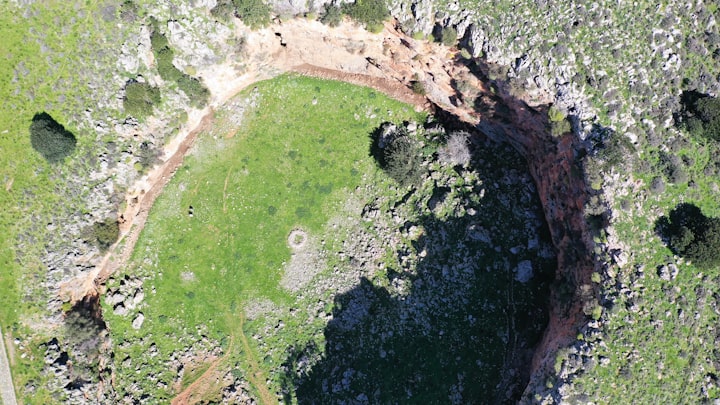
China’s Sinkhole Forest: An Enigmatic Natural Wonder
China is known for its picturesque landscapes, diverse cultural heritage, and bustling cities. However, hidden beneath the surface lies a mysterious and breathtaking phenomenon that has fascinated scientists and nature enthusiasts alike – the Sinkhole Forest of China.
Located in the southern Chinese province of Guangxi, the Sinkhole Forest, also known as the Stone Forest or Shilin in Mandarin, is a natural wonder that has been shaped over millions of years. This unique geological formation comprises a vast network of limestone pinnacles, pillars, and towers, resembling a forest of stone. The Sinkhole Forest covers an area of approximately 350 square kilometers and is believed to be over 270 million years old.
The Sinkhole Forest was formed through a process known as karstification, which occurs when soluble rocks such as limestone are eroded by water over an extended period. The limestone in the area was deposited during the Permian period and was gradually eroded by rainwater, creating a landscape of limestone peaks and valleys. The process continued as the landmass shifted, and the water found its way through the fractures in the rocks, gradually widening them into massive sinkholes.
Over time, the Sinkhole Forest has become home to a diverse ecosystem of flora and fauna, including rare and endemic species. The area is renowned for its unique geological and biological diversity, with over 900 different plant species, 70 types of mammals, and 100 bird species found within its boundaries. The Sinkhole Forest is also home to several endemic species, such as the Shilin Monkey and the Shilin Nightjar, which are only found in this region.
The Sinkhole Forest has been a popular tourist attraction for many years, with visitors from all over the world coming to marvel at its beauty and mystery. In 2007, it was designated a UNESCO World Heritage Site, acknowledging its unique geological and cultural significance. The Sinkhole Forest is also home to several ancient Chinese legends, which have been passed down through generations. One of the most popular legends is that of Ashima, a beautiful young girl who was turned into a stone pillar by an evil spirit. Today, her stone likeness stands tall in the Sinkhole Forest, and visitors can marvel at her beauty and pay their respects to her spirit.
Despite its beauty and significance, the Sinkhole Forest is facing several environmental challenges. The region is under threat from human activity, such as deforestation, agriculture, and tourism, which have caused significant damage to the ecosystem. In recent years, the Chinese government has taken measures to protect the Sinkhole Forest, including introducing regulations on tourism, investing in reforestation projects, and establishing nature reserves.
Discovery:
It is not clear who first discovered the Sinkhole Forest in China, as it has been a natural feature of the region for millions of years and has likely been known to the local people for centuries. However, the Sinkhole Forest became known to the wider world through the writings of European explorers and naturalists in the 19th century, who were fascinated by its unique geological and biological diversity. The first Westerner to describe the Sinkhole Forest in detail was the French missionary and botanist Jean-André Soulié, who visited the region in the early 19th century and wrote about it in his memoirs. Since then, the Sinkhole Forest has become a popular destination for tourists and scientists from around the world.
What are the creatures is there?
The Sinkhole Forest In China is home to a diverse ecosystem of flora and fauna, including several rare and endemic species. Some of the creatures found in the Sinkhole Forest include:
1. Shilin Monkey: Also known as the black-and-white snub-nosed monkey, this species is found only in the Sinkhole Forest region and is considered endangered. The monkeys have distinctive black and white fur and a unique, upturned nose.
2. Shilin Nightjar: This bird is found only in the Sinkhole Forest and is listed as vulnerable. It has a unique call and is active at night, making it difficult to spot.
3. Giant Salamander: This amphibian is one of the largest in the world, growing up to 1.8 meters in length. It is found in rivers and streams in the Sinkhole Forest and is considered critically endangered due to habitat loss and poaching.
4. Chinese Pangolin: This mammal is found in the Sinkhole Forest and is a critically endangered species. It has distinctive scales covering its body, which are highly sought after for use in traditional Chinese medicine.
5. Chinese Giant Flying Squirrel: This species of flying squirrel is found in the Sinkhole Forest and is one of the largest in the world, with a wingspan of up to 1.5 meters. It is considered vulnerable due to habitat loss.
6. Clouded Leopard: This large cat is found in the Sinkhole Forest and is listed as vulnerable. It has distinctive markings on its fur and is known for its agility and climbing ability.
7. Asian Black Bear: This bear species is found in the Sinkhole Forest and is considered vulnerable. It has black fur and a distinctive white V-shaped marking on its chest.
These are just a few of the many creatures found in the Sinkhole Forest, which is renowned for its unique biological diversity and endemic species.
In conclusion, the Sinkhole Forest of China is a unique and enigmatic natural wonder that has captured the imagination of people for centuries. Its geological and biological diversity, coupled with its cultural significance, make it a must-visit destination for anyone interested in nature and history. However, it is essential to remember that the Sinkhole Forest is a fragile ecosystem that requires protection and conservation. By supporting responsible tourism and sustainable practices, we can ensure that this magnificent natural wonder remains intact for generations to come.





Comments
There are no comments for this story
Be the first to respond and start the conversation.